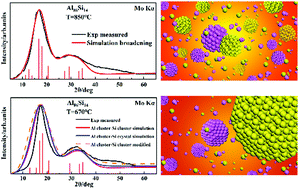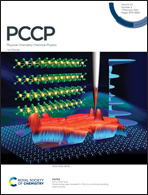The structure of metallic melts in eutectic alloys based on the Wulff cluster model: theory meets experiment†
Abstract
In the present work, the Wulff cluster model, which has been proved to be successful for pure metals and homogeneous alloys, has been extended to eutectic alloys (Ag–Cu and Al–Si). In our model, the shapes of the clusters in melts were determined by the interfacial energy calculated by density functional theory (DFT) of different facet families based on Wulff theory. The cluster size was given by the pair distribution function (PDF) g(r), which was converted from experimental high-temperature X-ray diffraction (HTXRD). The simulated XRD curves in the high temperature region were in good agreement with the experimental results. For the Al–Si alloy, a deviation of the intensity and position of the second peak near the eutectic temperature was observed. The simulated results after structure and composition modification corresponded to the experimental ones. It indicates that the deviation is mainly related to the significant change of the cluster size during Si clusters’ growth processes before nucleation. Differently, there are no such nucleation processes at temperatures near the eutectic point due to the relatively high nucleation barriers of the two components in the Ag–Cu alloy.



 Please wait while we load your content...
Please wait while we load your content...